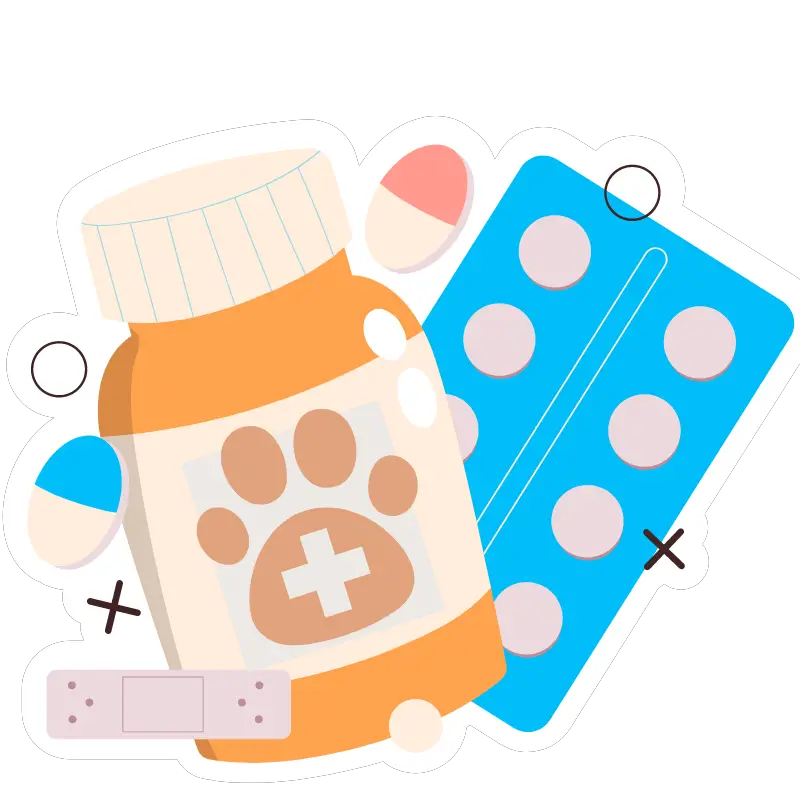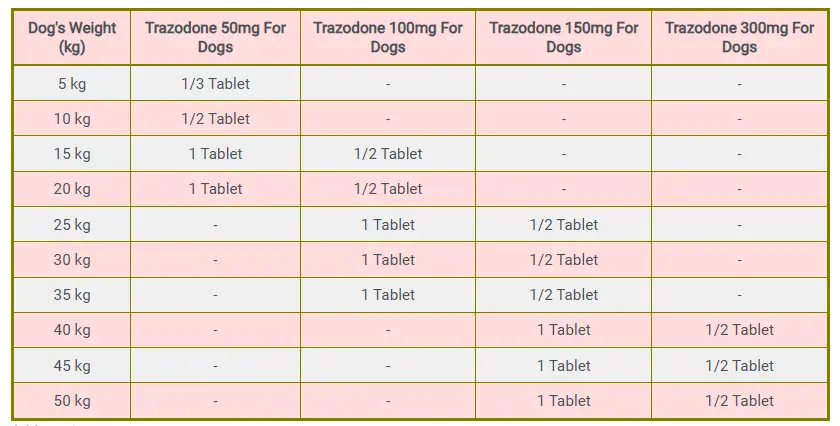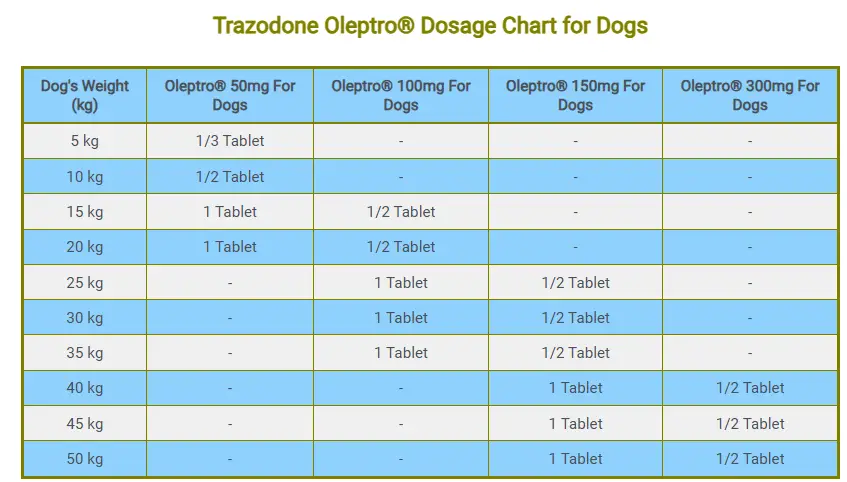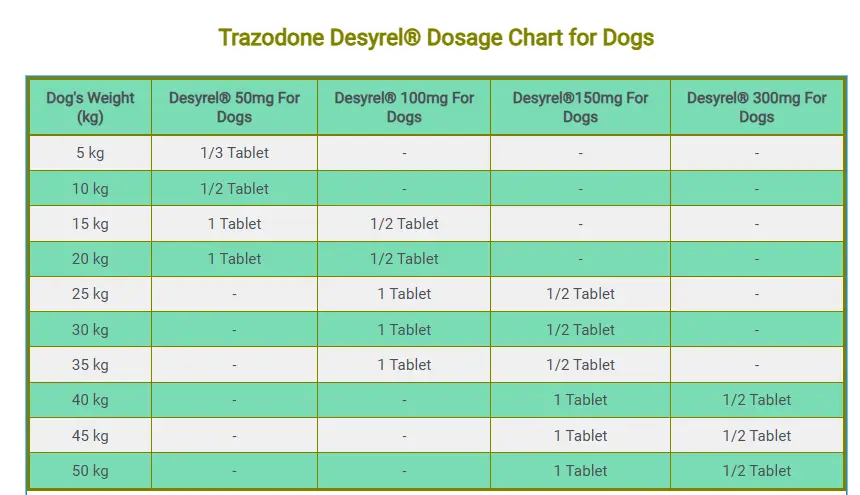Trazodone is a prescription medication primarily used as an antidepressant in humans. It belongs to a class of drugs known as serotonin modulators, which help to balance the levels of serotonin in the brain.
In veterinary medicine trazodone for dogs is used to manage anxiety and stress related issues, Behavioral Issues, Post-Surgical Sedation and Aggression Management in canines. It can be particularly helpful during stressful events like thunderstorms, fireworks, or visits to the veterinarian.
Trazodone For Dogs Overview
| Common Brands | Desyrel, Oleptro, generic trazodone |
| Ideal Dosage | 2-6 mg/kg (0.9-2.7 mg/lb) |
| Administration | Oral, in the form of tablets |
| Initial Dosage | 2-3 mg/kg |
| Maintenance Dosage | 5-6 mg/kg |
| Maximum Dosage | 10 mg/kg |
| Available Strength | 50mg. 100mg, 150mg, 300mg |
| Drugs That Interact | MAOIs, SSRIs, Risperidone, Quetiapine, Olanzapine, CNS Depressants, Antihypertensive Drugs, Antifungal Agents, Protease Inhibitors, Anticoagulants and Antiplatelet Drugs, Drugs Affecting the QT Interval |
What is Trazodone Used for in Dogs?
Trazodone for dogs is effective in reducing anxiety and stress in dogs, including separation anxiety, noise phobias (e.g., fear of thunderstorms or fireworks), and general anxiety. It helps dogs remain calm and comfortable during recovery from surgery or other medical procedures, minimizing movement and stress and promoting better healing.
Trazodone can also be used to manage behavioral disorders in dogs, such as aggression or compulsive behaviors, by promoting a sense of calmness.
To help dogs who are anxious about veterinary visits, grooming sessions, or other stressful situations, Trazodone may be given to ease their discomfort and make the experience less traumatic.
For dogs that experience anxiety during travel, Trazodone can help them stay relaxed during car rides or flights.
Is Trazodone Safe for Dogs?
Dog Trazodone is generally considered safe for dogs when prescribed by a veterinarian and used according to their instructions. However, like any medication, it comes with potential risks and side effects.
Trazodone Dosage for Dogs
The veterinarian-recommended trazodone dosage for dogs is 2-6 mg/kg (0.9-2.7 mg/lb) for the treatment of anxiety and stress-related issues like thunderstorms, fireworks, or visits to the veterinarian. In canines, trazodone takes about 1 hour to take effect for short-term anxiety relief but can take up to 3 hours for full effect.
For post-surgical sedation and during confinement and recovery periods for orthopedic patients, trazodone is generally given every 8 to 24 hours.
Most dogs experience anxiety relief within two hours of trazodone HCl administration. Trazodone is often given at a lower dose for a couple of days to reduce the potential for upset stomach side effects.
Dosage Guidelines
- Trazodone Dosage for Dogs Initial Dosage: Start with 2-3 mg/kg of the dog’s body weight.
- Maintenance Dosage: The dosage can be gradually increased to 5-6 mg/kg, based on the dog’s response and tolerance.
- Maximum Dosage: Do not exceed 10 mg/kg per day.
- Administer the dose once or twice daily, as prescribed by the veterinarian.
- It can be given with or without food but giving it with food may reduce gastrointestinal upset.
Note: Regarding dog Trazodone HCl Always follow the specific instructions provided by your veterinarian, as they will tailor the dosage based on your dog’s individual needs and medical history. Regular monitoring and adjustment may be necessary.
Factors Affecting Dosage
- Dog’s Weight
- Age
- Health Condition
- Severity of Symptoms
- Response to Medication
- Concurrent Medications
- Breed
- Tolerance Development
- Feeding Schedule
Trazodone Dosage Chart for Dogs by Weight
| Dog’s Weight (kg) | Dog’s Weight (lbs) | Initial Dose (2 mg/kg) | Targeted Dose (6 mg/kg) |
|---|---|---|---|
| 5 kg | 11 lbs | 10 mg | 30 mg |
| 6 kg | 13.2 lbs | 12 mg | 36 mg |
| 7 kg | 15.4 lbs | 14 mg | 42 mg |
| 8 kg | 17.6 lbs | 16 mg | 48 mg |
| 9 kg | 19.8 lbs | 18 mg | 54 mg |
| 10 kg | 22 lbs | 20 mg | 60 mg |
| 15 kg | 33 lbs | 30 mg | 90 mg |
| 20 kg | 44 lbs | 40 mg | 120 mg |
| 25 kg | 55 lbs | 50 mg | 150 mg |
| 30 kg | 66 lbs | 60 mg | 180 mg |
| 35 kg | 77 lbs | 70 mg | 210 mg |
| 40 kg | 88 lbs | 80 mg | 240 mg |
| 45 kg | 99 lbs | 90 mg | 270 mg |
| 50 kg | 110 lbs | 100 mg | 300 mg |
The above Trazodone dosage chart for dogs by weight is for educational purposes only and should never replace your veterinarian’s advice. Your veterinarian will determine the appropriate Trazodone HCl dosage for your dog based on its individual health condition.
Trazodone 50mg, 100 mg, 150 mg, and 300 mg Dosage Chart for Dogs
Dog Trazodone comes in 50 mg, 100 mg, 150 mg, and 300 mg tablets and requires a written prescription from a veterinarian in some states. The ideal dosage strength and tablets will depend entirely on your veterinarian’s prescription.
Follow the below trazodone dosage chart for dogs by weight.
| Dog’s Weight (kg) | Trazodone 50mg For Dogs | Trazodone 100mg For Dogs | Trazodone 150mg For Dogs | Trazodone 300mg For Dogs |
|---|---|---|---|---|
| 5 kg | 1/3 Tablet | – | – | – |
| 10 kg | 1/2 Tablet | – | – | – |
| 15 kg | 1 Tablet | 1/2 Tablet | – | – |
| 20 kg | 1 Tablet | 1/2 Tablet | – | – |
| 25 kg | – | 1 Tablet | 1/2 Tablet | – |
| 30 kg | – | 1 Tablet | 1/2 Tablet | – |
| 35 kg | – | 1 Tablet | 1/2 Tablet | – |
| 40 kg | – | – | 1 Tablet | 1/2 Tablet |
| 45 kg | – | – | 1 Tablet | 1/2 Tablet |
| 50 kg | – | – | 1 Tablet | 1/2 Tablet |
Trazodone Oleptro® Dosage Chart for Dogs
| Dog’s Weight (kg) | Oleptro® 50mg For Dogs | Oleptro® 100mg For Dogs | Oleptro® 150mg For Dogs | Oleptro® 300mg For Dogs |
|---|---|---|---|---|
| 5 kg | 1/3 Tablet | – | – | – |
| 10 kg | 1/2 Tablet | – | – | – |
| 15 kg | 1 Tablet | 1/2 Tablet | – | – |
| 20 kg | 1 Tablet | 1/2 Tablet | – | – |
| 25 kg | – | 1 Tablet | 1/2 Tablet | – |
| 30 kg | – | 1 Tablet | 1/2 Tablet | – |
| 35 kg | – | 1 Tablet | 1/2 Tablet | – |
| 40 kg | – | – | 1 Tablet | 1/2 Tablet |
| 45 kg | – | – | 1 Tablet | 1/2 Tablet |
| 50 kg | – | – | 1 Tablet | 1/2 Tablet |
Do not crush, chew, or break an Oleptro® Trazodone for dogs’ tablet. To maintain the recommended Oleptro® trazodone dosage, you may break the tablet in half along the score line if needed.
Trazodone Desyrel® Dosage Chart for Dogs
| Dog’s Weight (kg) | Desyrel® 50mg For Dogs | Desyrel® 100mg For Dogs | Desyrel®150mg For Dogs | Desyrel® 300mg For Dogs |
|---|---|---|---|---|
| 5 kg | 1/3 Tablet | – | – | – |
| 10 kg | 1/2 Tablet | – | – | – |
| 15 kg | 1 Tablet | 1/2 Tablet | – | – |
| 20 kg | 1 Tablet | 1/2 Tablet | – | – |
| 25 kg | – | 1 Tablet | 1/2 Tablet | – |
| 30 kg | – | 1 Tablet | 1/2 Tablet | – |
| 35 kg | – | 1 Tablet | 1/2 Tablet | – |
| 40 kg | – | – | 1 Tablet | 1/2 Tablet |
| 45 kg | – | – | 1 Tablet | 1/2 Tablet |
| 50 kg | – | – | 1 Tablet | 1/2 Tablet |
Trazodone For Fireworks Anxiety in Dogs

Fireworks can cause stress and anxiety in dogs due to their loud and unpredictable nature. Trazodone is an antidepressant that also has anti-anxiety properties, making it useful in these situations.
To treat fireworks anxiety in dogs, administer a dose of trazodone at 3 mg/kg ahead of the anticipated anxiety-inducing event. This should be done an hour or more before the fireworks are expected to start. Some canines may need a higher dose, up to 5 mg/kg, to address the issue. However, contact your vet before increasing the dose.
How Trazodone Helps with Fireworks Anxiety in Dogs:
- Trazodone HCl helps calm dogs by affecting serotonin levels in the brain. This can reduce the dog’s anxiety and help them remain calm during stressful events.
- It has sedative effects, which can help the dog sleep through the noise of fireworks.
- By reducing anxiety, trazodone can help prevent destructive behaviors that some dogs exhibit when they are scared.
How is Trazodone Given to Dogs?
- Trazodone is usually given by mouth in the form of a tablet.
- It can be given with or without food but giving it with food can help reduce the risk of gastrointestinal upset.
- It is important to follow the vet’s instructions regarding frequency and duration.
Trazodone Side Effects in Dogs
Common Side Effects
- Sedation or drowsiness
- Gastrointestinal upset (vomiting, diarrhea, loss of appetite)
- Behavioral changes
- Panting
Less Common Side Effects
- Increased appetite
- Ataxia (lack of coordination)
- Hypotension (low blood pressure)
- Tachycardia (increased heart rate)
Rare and Severe Side Effects
- Priapism (prolonged and painful erection)
- Seizures
- Serotonin syndrome (confusion, rapid heart rate, high blood pressure, muscle rigidity)
Allergic Reactions
- Skin rash or hives
- Swelling (face, lips, tongue)
- Difficulty breathing
Long-Term Side Effects
- Behavioral changes
- Dependence and withdrawal symptoms if abruptly discontinued
Action Steps
- Monitor closely for any symptoms
- Contact veterinarian if concerning side effects occur
- Seek emergency care for severe side effects
Risk Factors for Trazodone in Dogs
Dog Trazodone HCl, commonly prescribed for anxiety and behavioral disorders in dogs, can be beneficial but also carries potential risks. Understanding these risks is crucial for ensuring the safety and well-being of your pet.
1. Age and Health Conditions
- Senior Dogs: Older dogs are more susceptible to side effects due to potentially decreased organ function, especially liver and kidney issues, which are critical for drug metabolism and excretion.
- Liver or Kidney Disease: Dogs with compromised liver or kidney function may not metabolize trazodone effectively, leading to increased risk of toxicity.
2. Breed-Specific Sensitivities
- Brachycephalic Breeds: Breeds like Bulldogs, Pugs, and Boston Terriers, known for their short snouts and respiratory issues, might experience exacerbated breathing difficulties.
- Sighthounds: Breeds such as Greyhounds and Whippets might have increased sensitivity to medications due to their unique metabolism.
3. Concurrent Medications
- Antidepressants and Antianxiety Medications: Combining trazodone with other SSRIs, MAO inhibitors, or similar medications can increase the risk of serotonin syndrome, a potentially life-threatening condition.
- Nonsteroidal Anti-Inflammatory Drugs (NSAIDs): Concurrent use of NSAIDs and trazodone can increase the risk of gastrointestinal issues and bleeding.
4. Pre-existing Conditions
- Heart Disease: Trazodone can affect heart rate and blood pressure, posing risks for puppies with cardiac conditions.
- Seizure Disorders: Trazodone may lower the seizure threshold, increasing the risk for dogs with a history of seizures.
5. Behavioral and Psychological Factors
- Aggression: Dogs with aggressive tendencies might have their behavior exacerbated by trazodone, leading to increased risk of aggressive outbursts.
Which Dogs Should Avoid Trazodone
Given the above risk factors, certain canines should avoid trazodone or use it with extreme caution:
- Dogs with Severe Liver or Kidney Disease: These dogs may not metabolize trazodone properly, increasing the risk of adverse effects.
- Dogs with Serious Heart Conditions: The cardiovascular effects of trazodone can be dangerous for these pets.
- Dogs on MAO Inhibitors or SSRIs: The risk of serotonin syndrome makes trazodone a poor choice in combination with these drugs.
- Dogs with a History of Seizures: Since trazodone can lower the seizure threshold, it’s typically contraindicated in these cases.
- Pregnant or Lactating Dogs: The safety of trazodone in pregnant or lactating dogs has not been established, so it’s generally avoided to prevent potential harm to the mother or puppies.
Emergency Situations: What to Do
When administered correctly, Trazadone is safe for your furry friend. However, there can be instances of side effects or overdose. Pet owners must recognize these situations and know the appropriate steps to take.
- Stay Calm and Assess the Situation
- Observe your dog closely to identify specific symptoms.
- Note the time when symptoms first appeared, and the dosage given.
- Contact Your Veterinarian Immediately
- Explain the situation clearly, including the dose of trazodone given and the symptoms observed.
- Follow any immediate instructions provided by your veterinarian.
- Induce Vomiting (Only if Instructed by a Veterinarian)
- Use hydrogen peroxide to induce vomiting if recommended. Administer one teaspoon per 10 pounds, up to 3 teaspoons. However, this should only be done under professional guidance.
- Do Not Administer Any Other Medication
- Avoid giving your dog any other medications unless directed by a veterinarian, as this could complicate the situation.
- Keep Your Dog Comfortable
- Place your dog in a calm and quiet environment.
- Ensure they have access to water but avoid forcing them to drink.
- Prepare for Emergency Transport
- If the veterinarian recommends a visit, prepare to transport your dog safely. Use a carrier or a leash to keep your dog secure during transit.
- Gather Information
- Bring the medication bottle or packaging to help the veterinarian assess the situation more accurately.
Emergency Contact Information
Pet Poison Helpline:
- Phone: 855-764-7661
- Website: petpoisonhelpline.com
ASPCA Poison Control:
- Phone: 888-426-4435
- Website: aspca.org/pet-care/animal-poison-control
Common Drugs That Interact with Trazodone
Like many medications, trazodone can interact with various other drugs, leading to altered effects, increased side effects, or reduced efficacy. It’s crucial for patients and healthcare providers to be aware of these potential interactions to manage and mitigate risks effectively.
Monoamine Oxidase Inhibitors (MAOIs)
Examples: Phenelzine, Tranylcypromine, Isocarboxazid
Interaction: Combining trazodone with MAOIs can lead to severe and potentially life-threatening side effects, such as serotonin syndrome, which is characterized by confusion, hallucinations, seizures, extreme changes in blood pressure, increased heart rate, fever, and more.
A minimum of 14 days should elapse between stopping an MAOI and starting trazodone.
Other Antidepressants
Examples: SSRIs (Fluoxetine, Sertraline), SNRIs (Venlafaxine, Duloxetine), TCAs (Amitriptyline, Nortriptyline)
Interaction: Co-administration with other antidepressants can increase the risk of serotonin syndrome. Close monitoring is required, and dose adjustments may be necessary.
Antipsychotic Drugs
Examples: Risperidone, Quetiapine, Olanzapine
Interaction: These drugs may increase the sedative effects of trazodone and can elevate the risk of adverse effects like QT prolongation, which can lead to serious heart arrhythmias.
CNS Depressants
Examples: Benzodiazepines (Diazepam, Lorazepam), Alcohol, Barbiturates
Interaction: Concurrent use can enhance the sedative and depressant effects on the central nervous system, leading to increased drowsiness, dizziness, and risk of overdose.
Antihypertensive Drugs
Examples: Clonidine, Methyldopa
Interaction: Trazodone can potentiate the hypotensive effects of these medications, leading to an increased risk of low blood pressure, dizziness, and fainting.
Antifungal Agents
Examples: Ketoconazole, Itraconazole
Interaction: These drugs can inhibit the metabolism of trazodone, leading to increased levels of trazodone in the blood and a higher risk of side effects.
Protease Inhibitors
Examples: Ritonavir, Indinavir
Interaction: Similar to antifungal agents, protease inhibitors can inhibit the metabolism of trazodone, raising its levels and potentially increasing toxicity.
Antibiotics
Examples: Erythromycin, Clarithromycin
Interaction: These antibiotics can inhibit the enzyme CYP3A4, which is involved in trazodone metabolism, leading to elevated trazodone levels and enhanced side effects.
Anticoagulants and Antiplatelet Drugs
Examples: Warfarin, Aspirin, Clopidogrel
Interaction: Trazodone can affect blood clotting, and when combined with anticoagulants or antiplatelet drugs, the risk of bleeding may increase.
Antiseizure Medications
Examples: Phenytoin, Carbamazepine
Interaction: These drugs can either increase or decrease the levels of trazodone, affecting its efficacy and side effect profile.
Drugs Affecting the QT Interval
Examples: Amiodarone, Sotalol, Certain Antipsychotics
Interaction: Trazodone can prolong the QT interval and combining it with other drugs that have the same effect increases the risk of serious heart arrhythmias.
What Veterinarians Say About Dog Trazodone
Wendy Brooks, DVM, DABVP, says: “Trazodone is typically used to manage short-term canine and feline anxiety issues. It has been useful in helping orthopedic patients stay relaxed during confinement and recovery periods, as well as in other situations where anxiety is a problem such as travel, visits to the vet, fireworks, or thunderstorms.”
Dr. Attas says: “After administering trazodone to your furry friend, it is advisable to monitor your dog to ensure they’re not sitting up high where they might misjudge their step, fall, and hurt themselves.”
Dr. Jerry Klein, Chief Veterinary Officer for the AKC, says: “When prescribing trazodone for dogs, it is essential that veterinarians dose the dog based on that individual dog’s medical history and possible drug interaction concerns.”
Carmen Pope, BPharm, says: “In some dogs, trazodone may have the opposite effect to the one intended, causing hyperactivity or behavioral disinhibition—impulsive behaviors that are out of character for your dog.”
How to Store Trazodone
Store trazodone at room temperature, typically between 68°F and 77°F (20°C to 25°C). Avoid extreme temperatures. Keep the medication in a dry place. Avoid storing it in bathrooms or other areas with high humidity.
Store the medication in its original container, away from direct light. This helps protect it from degradation due to light exposure. Keep trazodone in its original container with the lid tightly closed. This helps prevent contamination and moisture from affecting the medication.
Ensure the medication is stored out of reach of children and pets to prevent accidental ingestion. Regularly check the expiration date on the medication bottle and do not use it past its expiration date.
Related Posts:
FAQs
Can You Use Gabapentin and Trazodone Together for Dogs?
Yes, gabapentin and trazodone can be used together in dogs, but only under the guidance of a veterinarian. These medications can be used together to manage anxiety and pain.
What to Do if a Dog Is Overexposed to Trazodone
If a dog is overexposed to trazodone, contact a veterinarian or an emergency animal hospital immediately. Symptoms of overdose may include sedation, lethargy, ataxia, vomiting, and potentially more severe effects like seizures.
How much trazodone will calm a dog?
The dosage of trazodone for calming a dog varies based on the dog’s weight, condition, and response to the medication. A common starting dose is around 2-5 mg/kg, but the exact dosage should be determined by a veterinarian.
How long will trazodone make a dog sleep?
Trazodone can make a dog sleepy for about 6-12 hours, depending on the dose and the individual dog’s metabolism and sensitivity to the medication.
Can a dog overdose on trazodone?
Yes, a dog can overdose on trazodone. Overdose symptoms include severe sedation, uncoordinated movements, respiratory depression, and seizures. Immediate veterinary attention is required in case of suspected overdose.
Why is my dog shaking after trazodone?
Shaking in a dog after taking trazodone could be a side effect of the medication, possibly indicating anxiety, muscle tremors, or other neurological effects. Contact a veterinarian if shaking persists or is severe.
Does trazodone make a dog thirsty?
Trazodone can cause increased thirst in some dogs as a side effect. Ensure your dog has access to fresh water and monitor their water intake and overall condition.
References:
https://bettervet.com/resources/pet-health-care/trazodone-for-dogs
https://todaysveterinarynurse.com/trazodone-in-veterinary-medicine/














![Can Dogs Eat Blood? 7 Side Effects [Expert Opinion]](https://petskor.com/wp-content/uploads/2022/04/Webp.net-resizeimage-12.jpg)
